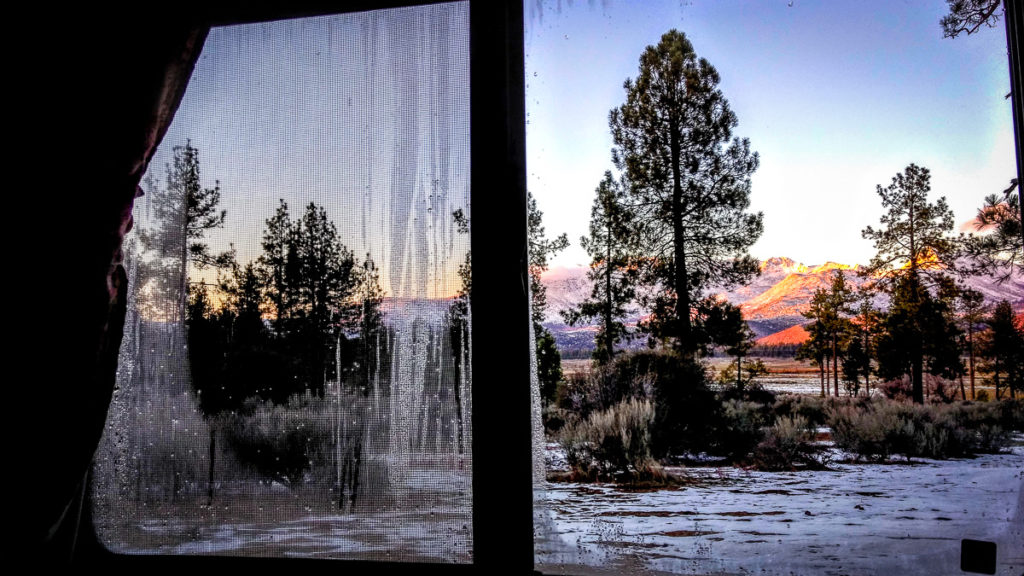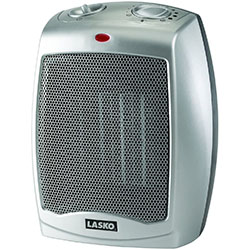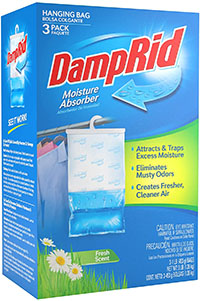The way most boondockers prevent condensation inside an RV is to use a dehumidifier, as well as a ceramic electric space heater. There are other products that can help with condensation in localized places. But otherwise, your trusty dehumidifier is the way most people deal with condensation.

How to Prevent Condensation Inside an RV
Running a dehumidifier as well as a ceramic electric space heater, are the two most common ways to prevent condensation inside an RV.
Dehumidifier

Most boondockers will tell you that “bigger is better” when it comes to getting a dehumidifier for your RV. They get typically get a unit that sits on the floor, with a 35 to 50-pint removal capacity. These plug into a standard wall outlet (running on 110 volt).
It also depends on how big your RV is, and how heavy the condensation is. We’ve heard of RVers with large 40+ foot rigs running as many as three dehumidifiers. We recommended starting out with just one and then decide later if you need to buy another.
A 35-pint dehumidifier (see it on Amazon) will require about 380 watts to run, while a 50-pint dehumidifier (see it on Amazon) will require about 1,000 watts.
You may find that condensation is only a problem in one part of your RV, and in that case, just a single 35-pint unit sitting in that area is sufficient.
Ceramic Electric Space Heater

If your RV, trailer, or van is small enough, you may find that a ceramic electric space heater is better.
Ceramic electric space heaters do not produce water vapor in the way propane heaters do. Much of the condensation inside your RV comes from running propane appliances, including your stove top, or portable propane heaters.
If you can heat up your space with a ceramic electric heater (or two), then you will have prevented much of the condensation problems that other boondockers get.
Ceramic electric heaters are the most widely available electric heaters on the market. They sell for about $40.00 at Wal-Mart, Home Depot, Lowes, Menards, True-Value, ACE Hardware, et al. The Lasko Ceramic Electric Heater (see it on Amazon) is the best selling unit in the United States.
These heaters will require 1,500 watts to run at their highest setting. All brands and styles of ceramic electric heaters require the same amount of watts, and produce the same amount of heat (5,000 to 5,200 BTUs).
Rubber-Backed Carpeting
The reason why condensation soaks up through your carpeting is because it’s not rubber-backed. Most carpeting and rugs that people buy are glue-backed. This allows condensation to soak up through and get your socks soggy.
Rubber-backed carpeting prevents water from soaking up through. Unfortunately, it’s harder to find. However, you can find lots on Amazon by searching, “rubber backed rugs”.
Damprid

Damprid is a brand of moisture absorber used to remove moisture from the air to prevent mold from growing. It’s not really intended to keep windows and floors dry inside RVs camped in freezing weather, though anything helps.
The best Damprid product are the hanging bags. These are intended to hang from closet rods or shower rods. They seem to remove more moisture than the Damprid plastic tubs.
Run Ceiling Fans to Blow Air Out
Blowing air out through roof vents is a great way to remove moisture in the air. To do this effectively, you will want to also crack open a window (preferably furthest from your generator exhaust pipe).
It may seem counter-productive to allow bitter-cold air to cycle through your RV, but it is very effective. You only need to cycle this air periodically, not continuously. Obviously, you will want to run heaters while doing this.
Note: It is not enough to just crack open a window or ceiling vent. You must blow the air out by using the ceiling fan. This is because the cold air outside is heavier, and will not allow warm air inside your RV to rise.
Block Wind From Blowing Underneath
When wind is allowed to blow underneath your trailer, motorhome, or van, the floor gets more cold. This allows condensation to form more quickly.
- Many RVers attach fabric panels around their vehicle as a drape against blowing wind. There are some companies that sell “RV skirts” for this purpose.
- Reflectix works pretty well as a skirt too.
- Cutting up plywood panels to line around your vehicle also works.
- You can also buy plastic storage tubs and line them around your RV. Make sure these tubs have lids on them, and place something heavy inside each tub to stop it from blowing away.

